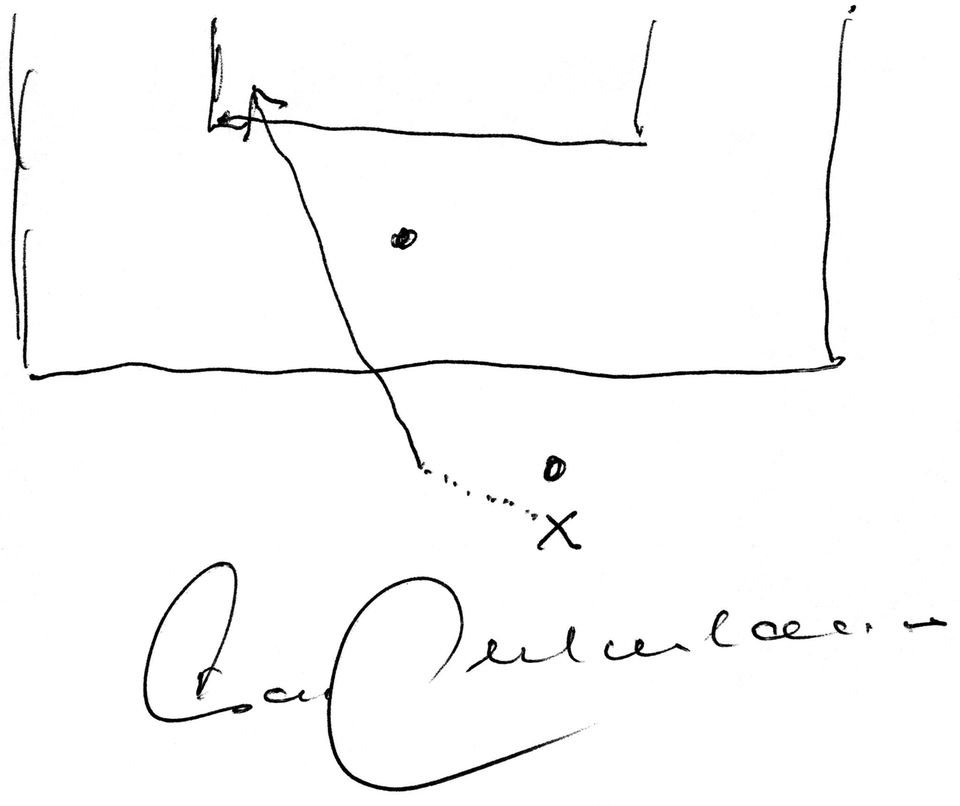Round thing
Big kick: football icons draw their most important goals
Carlos Valderama, 1990 World Cup, Colombia versus Saudi Arabia, final result: 2-0. The game in Bologna was “just” a preliminary round game, but a special one because Colombia was taking part in a World Cup again after almost 30 years.
© Carlos Valderrama / Insel Verlag
“Goals as Painted” is the name of the new book by SZ author Javier Cáceres, the idea behind it is as simple as it is ingenious: Franz Beckenbauer, Pelé and over 100 other stars scribble their most important goals on a piece of paper.
“Mr. Hitchcock, how did you do that?” is the title of a book by the French director François Truffaut. Published in 1966, it reproduces an approximately 50-hour interview between the master director and the master director. Truffaut, who also worked as a film critic, asked Alfred Hitchcock about his almost 50 films, and his colleague Helen Scott translated. The work is considered a classic of film history, full of details, insights and anecdotes, all from first hand.
Javier Cáceres, a journalist at the “Süddeutsche Zeitung” since 2002, didn’t have nearly as much time for his interviews, and footballers are also considered interview partners with a sometimes clear flow of speech. What Cáceres, born in Santiago de Chile in 1970, has put together in his recently published book “Goals as Painted” is all the more astonishing.
“The gate is the glory itself”
The foreword by Argentine football legend Jorge Valdano alone is a delight. How the 1986 world champion describes the overarching goal of the game of games, as emotional and blissful as a winning goal in stoppage time. “The goal is the glory itself,” sums up Valdano, and this can be clearly felt in the following 300-plus pages.
Javier Cáceres has been very close to his job as a football journalist for decades and has interviewed a number of players. One day the idea arose to not only let her talk, but to get her to draw. The motif – their most important goal, to paraphrase Truffaut: Mr. Beckenbauer, Monsieur Platini, Señor Di Stefano, Ms. Künzer, Mister Lineker, how did you do that?
The result is an intensive contemporary document that provides snapshots of the producers themselves. Who could describe a goal more impressively than the scorer himself? If there is also a drawing of himself, even better. As expected, the stylistic range is wide.

HSV against Bayern Munich on May 5, 1984 in the Volksparkstadion: “I lift him over this one player – and hit him in the corner,” remembers Jimmy Hartwig. Better yet: Hamburg won 2-1.
© Jimmy Harwig / Insel Verlag
Carlos Valderrama’s 2-0 win over Colombia at the 1990 World Cup looks almost as disheveled as the kicker’s hairstyle. You can almost hear Jimmy Hartwig’s voice during HSV’s 1-0 win against Bayern (final score 2-1) from the 1983/84 season: “There was someone standing here. There was someone standing here. There was one standing here. There was one standing here. There was standing here “Jimmy”, plus the players as clowns – great.
Jay Jay Okocha lets ants type across the picture
Kaiser Franz outlines it concisely and to the point, as does Günther Netzer. Jay Jay Okocha has ants typing across the picture and Alfredo di Stéfano’s drawing could also adorn a teenager’s school desk – sometimes it looks like a telephone scribble, sometimes like a tactics board, authentic across the board, even in the simplest line.
“Goals as if painted” began in 2005. At that time, Javier Cáceres was sitting with Leonel Sánchez, one of the Chilean heroes of the 1962 World Cup. On a memorable evening, after a few beers, he drew his goal in the 1-0 win against Russia ( Final score 2:1). Equally memorable was the encounter with Gerd Müller and the circumstances surrounding his drawing or the complications in the case of Günther Netzer, as Cáceres recounts in the afterword, which is worth reading.
1966 World Cup, semi-final against the Soviet Union on July 25th. Franz Beckenbauer makes it 2-0. The Germans made it to the final against England, where another goal was scored that one would like to see a detailed drawing of…
© Franz Beckenbauer / Insel Verlag
Cáceres collected all of these drawings in a small Moleskine notebook, and now he is making them available to fans in this book, which is worth reading and seeing. Who came up with the cover photo, which only gives the goal a net where the ball flies? That shouldn’t be revealed at this point. A little tip: The man netted four figures. Or so they claim.
“The book is more than a book, it is great fun and a great adventure, a journalistic masterpiece,” wrote the critic Benjamin Henrichs in the “Süddeutsche” about Truffaut’s “Mr. Hitchcock, how did you do that?” . A praise that can be passed directly on to Javier Cáceres: “Goals as if painted” is a book as if painted, a kick from the first to the last page.



